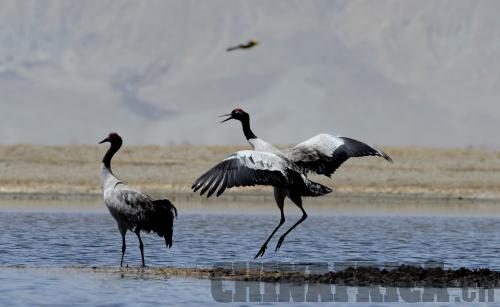| 
Pan Jie must stay highly alert every time he goes on duty. Operating in Fangchenggang City, Pan, a border inspector, is constantly on the lookout for wildlife smugglers who are active in the area.
An important gateway to Southeast Asia, the city, located in south China's Guangxi Zhuang Autonomous Region, is a nexus for illegal wildlife trade, including the smuggling of ivory, rhino horns and pangolin scales from Africa. On June 15, Pan helped local border police seize 160 boxes of reptiles that were being smuggled into China. Weighing 6.5 tons, the shipment included protected species of cobras and geochelone, a species of tortoise.
But this bust is only a small part of China's intensive fight against wildlife trafficking. Another recent case on May 22 resulted in customs officers in Manzhouli City, north China's Inner Mongolia Autonomous Region, confiscating 213 bear paws that were being smuggled by two Russian men. The seized paws have an estimated worth of around 2.8 million yuan ($460,000), making this the biggest seizure of bear paws in China's history.
Chinese law stipulates that those smuggling nationally protected species and their derivatives can be sentenced up to over 10 years in prison for the most serious infractions.
"These cases are proof that China is working harder than ever to crack down on illegal wildlife trade," said Yin Hong, Vice Minister of China's State Forestry Administration (SFA), at a press briefing in May that covered China's efforts to protect wild animals. Yin also noted that the crackdown showed improvements in law enforcement efficiency.
As a responsible stakeholder, China has been doing its best to protect world wildlife by establishing a complete network of nature reserves and a regulatory system for wildlife trade. At the same time, the nation is also taking initiative in building international cooperation to fight cross-border smuggling of protected wildlife.

Protection network
Yin said that the declining population trends of China's endangered animals, including giant pandas and Siberian tigers, have been reversed. The latest wildlife census released at the press conference showed that the number of wild Siberian tigers has risen from 12 to 16 in 2000 to current numbers of 18 to 22, and there are more than 1,700 crested ibis now living in the wild and in captivity compared to only seven in 1981. The number of giant pandas in the wild and in captivity has also climbed, reaching 1,596 and 341 respectively. The total number of Chinese alligators also increased to more than 10,000 from only 300 in the 1980s.
"One reason for these increases is the growing area of natural reserves," said Yin. China has established 2,150 nature reserves, helping to conserve 85 percent of the nation's protected wildlife.
This population growth is also attributed to the wildlife monitoring and prevention system created to control disease, said Yin. There are now 350 national, 768 provincial and a number of county-level monitoring stations that run nearly 10,000 monitoring sites and patrol routes. "They [the monitoring stations] have also been vital in monitoring past bird flu epidemics," she said.
In addition, China is enforcing new laws and regulations, implementing a labeling system for ivory products and setting up a national coordination group that deals with conservation issues.
Public awareness
More and more activists from the private sector are getting involved in wildlife protection, with a large number of animal protection efforts being run by non-governmental organizations and environmental activists. Zhou Xinyi, a senior at Yangzhou University, is one such activist. With her classmates, Zhou initiated a campaign aimed at increasing public awareness of red-crowned cranes, a protected species in China, by investigating the ecosystem on which they depend.
"We hope to make a difference through our efforts to influence policymaking and raise public awareness," said Zhou.
Authorities are taking steps to the support the private sector's role in conserving protected species. "Animal rights organizations and activists can be trusted and depended on in regard to wildlife protection," said Yin. "We encourage them to play a more important role in educating the public and supervising illegal activities," she added.

International cooperation
Illegal trade in wildlife is an international crime that can only be effectively curbed through coordinated efforts by origin, transit and destination countries, said Wan Ziming, Director of Enforcement and Training at the Endangered Species Import and Export Management Office of SFA.
China joined the Convention on International Trade in Endangered Species (CITES) in 1981 to regulate trade in wildlife and foster international cooperation. CITES aims to prevent international trade from threatening the survival of wild flora and fauna. Today, it remains one of the world's most powerful tools for this purpose.
"In the more than 30 years since China joined CITES, the nation has actively fulfilled its responsibilities, participated in international cooperation and played an important role in wildlife protection and trade regulation," said John E. Scanlon, Secretary General of CITES at the 16th meeting of its Conference of the Parties, held this March in Bangkok, Thailand.
China also takes initiative in clamping down on transnational wildlife crimes. An operation codenamed Cobra, led by the Chinese Government from January 6 to February 5 of this year, brought together police, customs and wildlife officers from 22 countries in Asia and Africa, to crack down on the smuggling of some key species, such as Asian big cats, elephants, great apes, pangolins and rhinos.
As part of the operation, 6.5 tons of ivory, 1.55 tons of Tibetan antelope hides, 22 rhino horns, 10 tiger hides and other products made from CITES-listed protected species, along with live animals, were confiscated.
In addition to detecting and seizing contraband, Operation Cobra aimed to effectively conduct following-up investigations and use specialized investigation techniques to pursue all possible leads to target the entire criminal chain, said Scanlon.
"The operation provided an excellent opportunity for all authorities involved to exchange ways and means of combating wildlife crimes, and to establish new professional relationships with their counterparts from different agencies, countries and regions of the world," said Wan Ziming. CA
∗ houweili@chinafrica.cn |